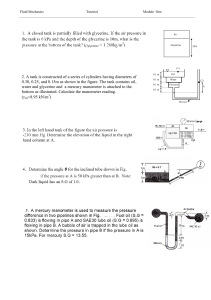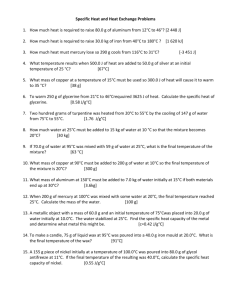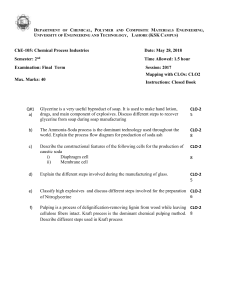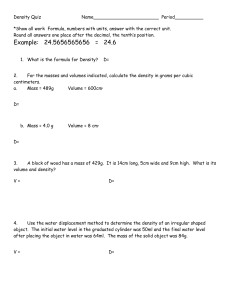dokumen.tips safety-data-sheet-glycerine-glycerine-viscosity-1300-1500-mpa-s-20c
advertisement
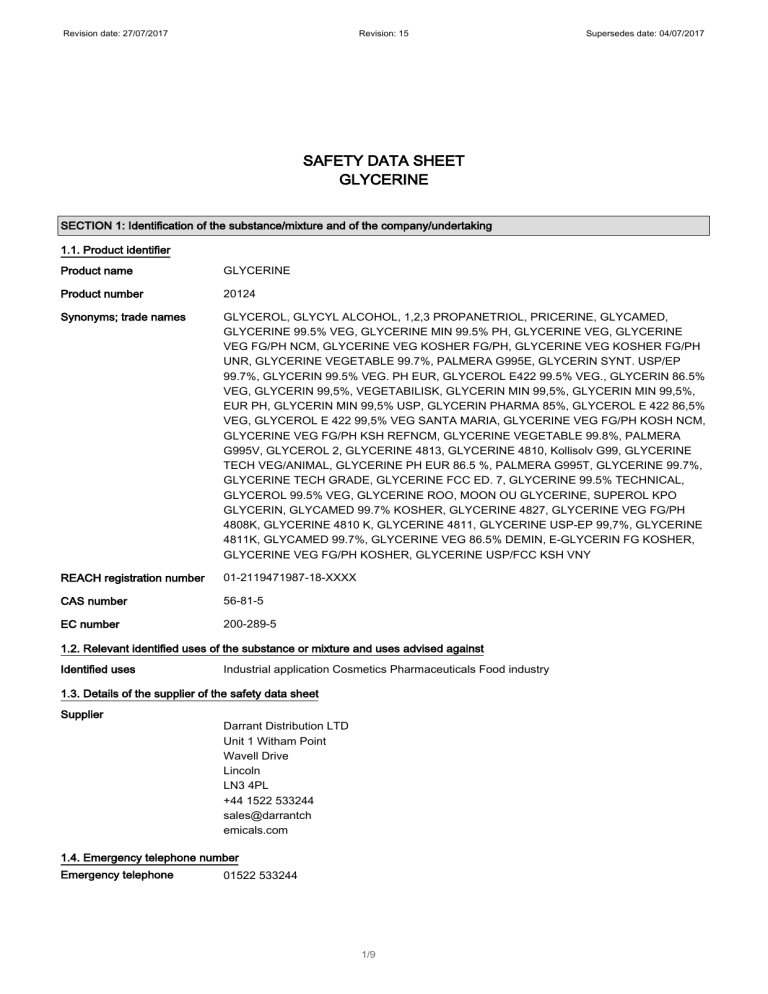
Revision date: 27/07/2017 Revision: 15 Supersedes date: 04/07/2017 SAFETY DATA SHEET GLYCERINE SECTION 1: Identification of the substance/mixture and of the company/undertaking 1.1. Product identifier Product name GLYCERINE Product number 20124 Synonyms; trade names GLYCEROL, GLYCYL ALCOHOL, 1,2,3 PROPANETRIOL, PRICERINE, GLYCAMED, GLYCERINE 99.5% VEG, GLYCERINE MIN 99.5% PH, GLYCERINE VEG, GLYCERINE VEG FG/PH NCM, GLYCERINE VEG KOSHER FG/PH, GLYCERINE VEG KOSHER FG/PH UNR, GLYCERINE VEGETABLE 99.7%, PALMERA G995E, GLYCERIN SYNT. USP/EP 99.7%, GLYCERIN 99.5% VEG. PH EUR, GLYCEROL E422 99.5% VEG., GLYCERIN 86.5% VEG, GLYCERIN 99,5%, VEGETABILISK, GLYCERIN MIN 99,5%, GLYCERIN MIN 99,5%, EUR PH, GLYCERIN MIN 99,5% USP, GLYCERIN PHARMA 85%, GLYCEROL E 422 86,5% VEG, GLYCEROL E 422 99,5% VEG SANTA MARIA, GLYCERINE VEG FG/PH KOSH NCM, GLYCERINE VEG FG/PH KSH REFNCM, GLYCERINE VEGETABLE 99.8%, PALMERA G995V, GLYCEROL 2, GLYCERINE 4813, GLYCERINE 4810, Kollisolv G99, GLYCERINE TECH VEG/ANIMAL, GLYCERINE PH EUR 86.5 %, PALMERA G995T, GLYCERINE 99.7%, GLYCERINE TECH GRADE, GLYCERINE FCC ED. 7, GLYCERINE 99.5% TECHNICAL, GLYCEROL 99.5% VEG, GLYCERINE ROO, MOON OU GLYCERINE, SUPEROL KPO GLYCERIN, GLYCAMED 99.7% KOSHER, GLYCERINE 4827, GLYCERINE VEG FG/PH 4808K, GLYCERINE 4810 K, GLYCERINE 4811, GLYCERINE USP-EP 99,7%, GLYCERINE 4811K, GLYCAMED 99.7%, GLYCERINE VEG 86.5% DEMIN, E-GLYCERIN FG KOSHER, GLYCERINE VEG FG/PH KOSHER, GLYCERINE USP/FCC KSH VNY REACH registration number 01-2119471987-18-XXXX CAS number 56-81-5 EC number 200-289-5 1.2. Relevant identified uses of the substance or mixture and uses advised against Identified uses Industrial application Cosmetics Pharmaceuticals Food industry 1.3. Details of the supplier of the safety data sheet Supplier Darrant Distribution LTD Unit 1 Witham Point Wavell Drive Lincoln LN3 4PL +44 1522 533244 sales@darrantch emicals.com 1.4. Emergency telephone number Emergency telephone 01522 533244 1/9 Revision date: 27/07/2017 Revision: 15 Supersedes date: 04/07/2017 GLYCERINE SECTION 2: Hazards identification 2.1. Classification of the substance or mixture Classification (EC 1272/2008) Physical hazards Not Classified Health hazards Not Classified Environmental hazards Not Classified 2.2. Label elements EC number 200-289-5 Hazard statements NC Not Classified 2.3. Other hazards This substance is not classified as PBT or vPvB according to current EU criteria. SECTION 3: Composition/information on ingredients 3.1. Substances Product name GLYCERINE REACH registration number 01-2119471987-18-XXXX CAS number 56-81-5 EC number 200-289-5 SECTION 4: First aid measures 4.1. Description of first aid measures Inhalation Move affected person to fresh air at once. Rinse nose and mouth with water. Get medical attention if any discomfort continues. Ingestion Rinse mouth thoroughly with water. Do not induce vomiting. If vomiting occurs, the head should be kept low so that stomach vomit doesn't enter the lungs. Give plenty of water to drink. Get medical attention if any discomfort continues. Skin contact Remove affected person from source of contamination. Remove contaminated clothing. Wash skin thoroughly with soap and water. Get medical attention if any discomfort continues. Eye contact Remove any contact lenses and open eyelids wide apart. Rinse immediately with plenty of water. Continue to rinse for at least 15 minutes. Get medical attention if any discomfort continues. 4.2. Most important symptoms and effects, both acute and delayed Inhalation Gas or vapour in high concentrations may irritate the respiratory system. Eye contact May cause temporary eye irritation. 4.3. Indication of any immediate medical attention and special treatment needed Notes for the doctor Treat symptomatically. SECTION 5: Firefighting measures 5.1. Extinguishing media Suitable extinguishing media Extinguish with alcohol-resistant foam, carbon dioxide, dry powder or water fog. Unsuitable extinguishing media Do not use water jet as an extinguisher, as this will spread the fire. 2/9 Revision date: 27/07/2017 Revision: 15 Supersedes date: 04/07/2017 GLYCERINE 5.2. Special hazards arising from the substance or mixture Hazardous combustion products Thermal decomposition or combustion may liberate carbon oxides and other toxic gases or vapours. 5.3. Advice for firefighters Special protective equipment for firefighters Wear positive-pressure self-contained breathing apparatus (SCBA) and appropriate protective clothing. SECTION 6: Accidental release measures 6.1. Personal precautions, protective equipment and emergency procedures Personal precautions Avoid inhalation of vapours and contact with skin and eyes. Wear protective clothing as described in Section 8 of this safety data sheet. Provide adequate ventilation. 6.2. Environmental precautions Environmental precautions Do not discharge into drains or watercourses or onto the ground. Spillages or uncontrolled discharges into watercourses must be reported immediately to the Environmental Agency or other appropriate regulatory body. 6.3. Methods and material for containment and cleaning up Methods for cleaning up Stop leak if possible without risk. Absorb in vermiculite, dry sand or earth and place into containers. Flush contaminated area with plenty of water. Avoid the spillage or runoff entering drains, sewers or watercourses. 6.4. Reference to other sections Reference to other sections For personal protection, see Section 8. For waste disposal, see Section 13. SECTION 7: Handling and storage 7.1. Precautions for safe handling Usage precautions Avoid inhalation of vapours and contact with skin and eyes. Provide adequate ventilation. 7.2. Conditions for safe storage, including any incompatibilities Storage precautions Store in tightly-closed, original container in a dry, cool and well-ventilated place. 7.3. Specific end use(s) Specific end use(s) The identified uses for this product are detailed in Section 1.2. SECTION 8: Exposure Controls/personal protection 8.1. Control parameters Occupational exposure limits Long-term exposure limit (8-hour TWA): WEL 10 mg/m³ mist WEL = Workplace Exposure Limit Ingredient comments WEL = Workplace Exposure Limits DNEL Industry - Inhalation; Long term local effects: 56 mg/m³ PNEC - Fresh water; 0.885 mg/l - Marine water; 0.0885 mg/l - Intermittent release; 8.85 mg/l - STP; 1000 mg/l - Soil; 0.141 mg/kg - Sediment (Freshwater); 3.3 mg/kg - Sediment (Marinewater); 0.33 mg/kg 3/9 Revision date: 27/07/2017 Revision: 15 Supersedes date: 04/07/2017 GLYCERINE 8.2. Exposure controls Protective equipment Appropriate engineering controls Provide adequate ventilation. Eye/face protection The following protection should be worn: Chemical splash goggles. EN 166 Hand protection Wear protective gloves. The most suitable glove should be chosen in consultation with the glove supplier/manufacturer, who can provide information about the breakthrough time of the glove material. EN 374 Hygiene measures Wash at the end of each work shift and before eating, smoking and using the toilet. Respiratory protection In case of inadequate ventilation or when the product is heated, use suitable respiratory equipment with gas filter (type A2). EN 136/140/145/143/149 SECTION 9: Physical and Chemical Properties 9.1. Information on basic physical and chemical properties Appearance Liquid. Colour Colourless. Yellow. Orange. Odour No information available. Odour threshold No information available. pH pH (concentrated solution): 5 - 8 Melting point ~ 18°C Initial boiling point and range 290°C @ 760 mm Hg Flash point > 199°C PMCC (Pensky-Martens closed cup). Evaporation rate No information available. Evaporation factor No information available. Flammability (solid, gas) No information available. Upper/lower flammability or explosive limits No information available. Other flammability No information available. Vapour pressure < 1 Pa @ 20°C Vapour density No information available. Relative density 1.26 @ 20°C Bulk density No information available. Solubility(ies) Soluble in water. Soluble in the following materials: Ethanol. acetone Partition coefficient log Pow: -1.76 Auto-ignition temperature 370°C Decomposition Temperature No information available. 4/9 Revision date: 27/07/2017 Revision: 15 Supersedes date: 04/07/2017 GLYCERINE Viscosity 1300 - 1500 mPa s @ 20°C Explosive properties No information available. Explosive under the influence No information available. of a flame Oxidising properties No information available. 9.2. Other information Other information No information required. Refractive index No information available. Particle size No information available. Molecular weight No information available. Volatility No information available. Saturation concentration No information available. Critical temperature No information available. Volatile organic compound No information available. SECTION 10: Stability and reactivity 10.1. Reactivity Reactivity The following materials may react with the product: Oxidising materials. Acids. 10.2. Chemical stability Stability The substance is hygroscopic and will absorb water by contact with the moisture in the air. 10.3. Possibility of hazardous reactions Possibility of hazardous reactions No information available. 10.4. Conditions to avoid Conditions to avoid Avoid excessive heat for prolonged periods of time. Water, moisture. 10.5. Incompatible materials Materials to avoid Strong acids. Strong alkalis. Strong oxidising agents. 10.6. Hazardous decomposition products Hazardous decomposition products Thermal decomposition or combustion may liberate carbon oxides and other toxic gases or vapours. SECTION 11: Toxicological information 11.1. Information on toxicological effects Acute toxicity - oral Acute toxicity oral (LD₅₀ mg/kg) 27,200.0 Species Rat ATE oral (mg/kg) 27,200.0 Skin corrosion/irritation Animal data No information available. 5/9 Revision date: 27/07/2017 Revision: 15 Supersedes date: 04/07/2017 GLYCERINE Serious eye damage/irritation Serious eye damage/irritation No information available. Respiratory sensitisation Respiratory sensitisation No information available. Skin sensitisation Skin sensitisation No information available. Germ cell mutagenicity Genotoxicity - in vitro No information available. Carcinogenicity Carcinogenicity No information available. Reproductive toxicity Reproductive toxicity - fertility No information available. Specific target organ toxicity - single exposure STOT - single exposure No information available. Specific target organ toxicity - repeated exposure STOT - repeated exposure No information available. Aspiration hazard Aspiration hazard No information available. Inhalation Gas or vapour in high concentrations may irritate the respiratory system. Ingestion May cause discomfort if swallowed. Skin contact No specific health hazards known. Eye contact May cause temporary eye irritation. SECTION 12: Ecological Information Ecotoxicity The product components are not classified as environmentally hazardous. However, this does not exclude the possibility that large or frequent spills can have a harmful or damaging effect on the environment. 12.1. Toxicity Toxicity Not considered toxic to fish. Acute toxicity - fish LC50, 96 hours: 54000 mg/l, Onchorhynchus mykiss (Rainbow trout) Acute toxicity - aquatic invertebrates EC₅₀, 24 hours: > 10000 mg/l, Daphnia magna Acute toxicity - aquatic plants EC₅₀, 72 hours: > 2900 mg/l, Freshwater algae Acute toxicity microorganisms EC₅₀, : > 1000 mg/l, Activated sludge 12.2. Persistence and degradability Persistence and degradability The product is biodegradable. 12.3. Bioaccumulative potential Bioaccumulative potential The product does not contain any substances expected to be bioaccumulating. 6/9 Revision date: 27/07/2017 Revision: 15 Supersedes date: 04/07/2017 GLYCERINE Partition coefficient log Pow: -1.76 12.4. Mobility in soil Mobility The product is soluble in water. 12.5. Results of PBT and vPvB assessment Results of PBT and vPvB assessment This substance is not classified as PBT or vPvB according to current EU criteria. 12.6. Other adverse effects Other adverse effects No information available. SECTION 13: Disposal considerations 13.1. Waste treatment methods General information Waste should be treated as controlled waste. Do not puncture or incinerate, even when empty. Disposal methods Dispose of waste to licensed waste disposal site in accordance with the requirements of the local Waste Disposal Authority. SECTION 14: Transport information General The product is not covered by international regulations on the transport of dangerous goods (IMDG, IATA, ADR/RID). 14.1. UN number Not applicable. 14.2. UN proper shipping name Not applicable. 14.3. Transport hazard class(es) No transport warning sign required. 14.4. Packing group Not applicable. 14.5. Environmental hazards Environmentally hazardous substance/marine pollutant No. 14.6. Special precautions for user Not applicable. 14.7. Transport in bulk according to Annex II of MARPOL and the IBC Code Transport in bulk according to Not applicable. Annex II of MARPOL 73/78 and the IBC Code SECTION 15: Regulatory information 15.1. Safety, health and environmental regulations/legislation specific for the substance or mixture 7/9 Revision date: 27/07/2017 Revision: 15 Supersedes date: 04/07/2017 GLYCERINE EU legislation Regulation (EC) No 1907/2006 of the European Parliament and of the Council of 18 December 2006 concerning the Registration, Evaluation, Authorisation and Restriction of Chemicals (REACH) (as amended). Regulation (EC) No 1272/2008 of the European Parliament and of the Council of 16 December 2008 on classification, labelling and packaging of substances and mixtures (as amended). Commission Regulation (EU) No 2015/830 of 28 May 2015. Inventory Information EINECS TSCA AICS DSL ECL ENCS IECS NZIOC PICCS 15.2. Chemical safety assessment A chemical safety assessment has been carried out. SECTION 16: Other information Abbreviations and acronyms used in the safety data sheet ATE: Acute Toxicity Estimate. ADR: European Agreement concerning the International Carriage of Dangerous Goods by Road. ADN: European Agreement concerning the International Carriage of Dangerous Goods by Inland Waterways. CAS: Chemical Abstracts Service. DNEL: Derived No Effect Level. IATA: International Air Transport Association. IMDG: International Maritime Dangerous Goods. Kow: Octanol-water partition coefficient. LC₅₀: Lethal Concentration to 50 % of a test population. LD₅₀: Lethal Dose to 50% of a test population (Median Lethal Dose). PBT: Persistent, Bioaccumulative and Toxic substance. PNEC: Predicted No Effect Concentration. REACH: Registration, Evaluation, Authorisation and Restriction of Chemicals Regulation (EC) No 1907/2006. RID: European Agreement concerning the International Carriage of Dangerous Goods by Rail. vPvB: Very Persistent and Very Bioaccumulative. IARC: International Agency for Research on Cancer. MARPOL 73/78: International Convention for the Prevention of Pollution From Ships, 1973 as modified by the Protocol of 1978. cATpE: Converted Acute Toxicity Point Estimate. BCF: Bioconcentration Factor. BOD: Biochemical Oxygen Demand. EC₅₀: 50% of maximal Effective Concentration. LOAEC: Lowest Observed Adverse Effect Concentration. LOAEL: Lowest Observed Adverse Effect Level. NOAEC: No Observed Adverse Effect Concentration. NOAEL: No Observed Adverse Effect Level. NOEC: No Observed Effect Concentration. LOEC: Lowest Observed Effect Concentration. DMEL: Derived Minimal Effect Level. EL50: Exposure Limit 50 hPa: Hectopascal LL50: Lethal Loading fifty OECD: Organisation for Economic Co-operation and Development POW: Octanol-water partition coefficient SCBA: self-contained breathing apparatus STP: Sewage Treatment Plant VOC: Volatile Organic Compounds 8/9 Revision date: 27/07/2017 Revision: 15 Supersedes date: 04/07/2017 GLYCERINE Classification abbreviations and acronyms Acute Tox. = Acute toxicity Aquatic Acute = Hazardous to the aquatic environment (acute) Aquatic Chronic = Hazardous to the aquatic environment (chronic) Key literature references and sources for data Supplier's information. Revision comments NOTE: Lines within the margin indicate significant changes from the previous revision. Revision date 27/07/2017 Revision 15 Supersedes date 04/07/2017 SDS number 20124 Version number 1.010 SDS status Approved. Signature Lisa Bland 9/9
